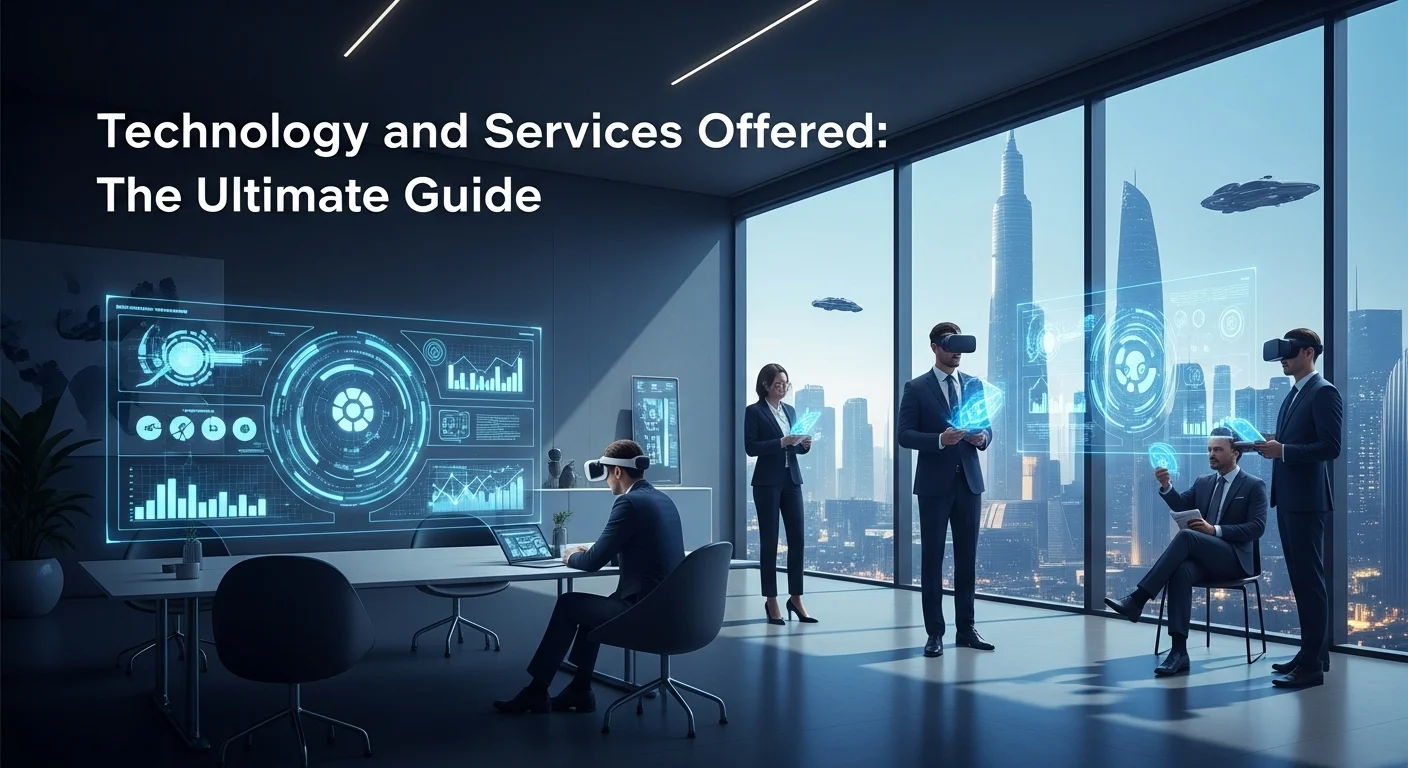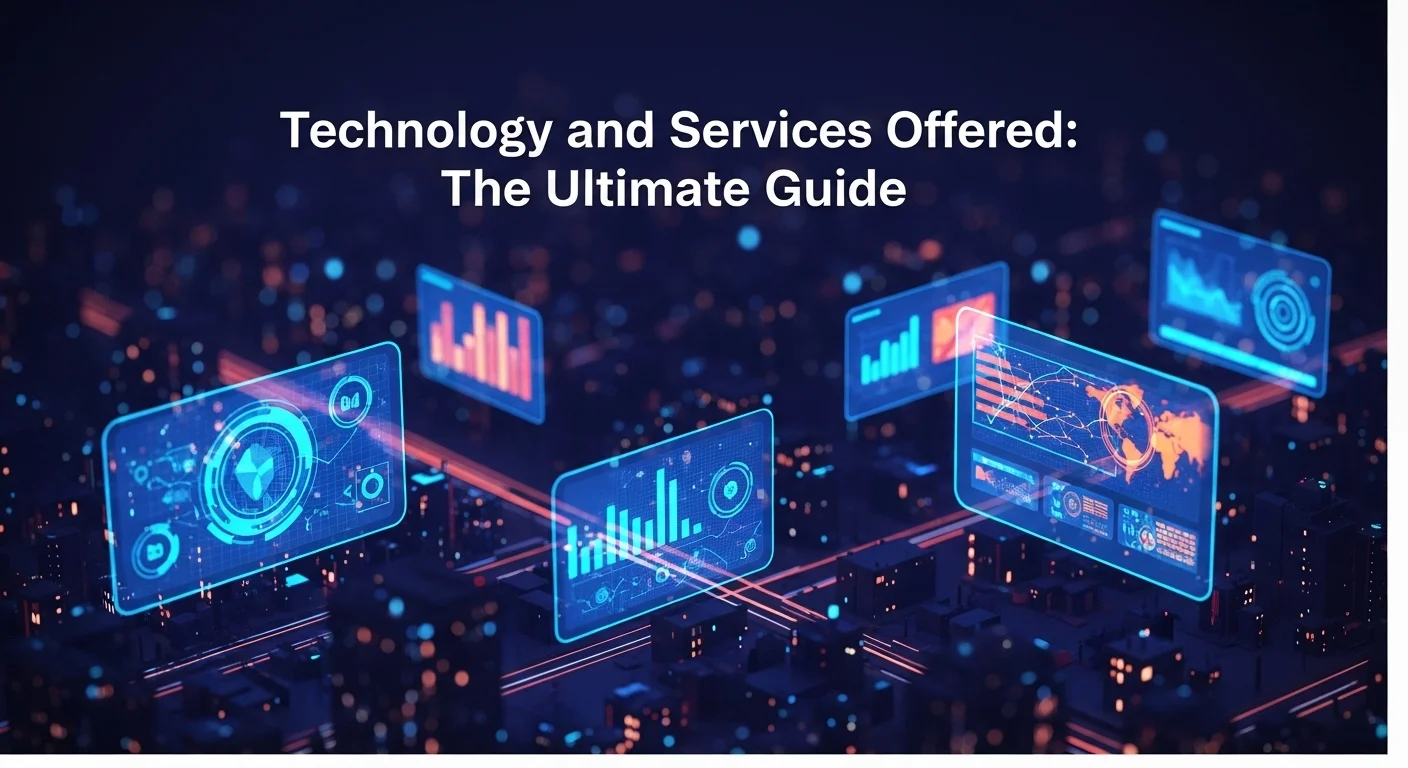My Guide to Tech Services: How IaaS, PaaS, and SaaS Really Work

Executive Summary
I've spent years in the tech world, and I've seen the term 'Services Offered' go from a simple sales pitch to the very engine of modern business. It's not just about buying software anymore; it's about building a dynamic relationship with technology. In this guide, I want to pull back the curtain on what that really means, focusing on the game-changer: cloud computing. We’ll walk through the essential models—Infrastructure as a Service (IaaS), Platform as a Service (PaaS), and Software as a Service (SaaS)—which are the building blocks of any smart IT strategy today. Trust me, understanding these isn't just for techies anymore. For any business looking to innovate, scale, and stay ahead, this knowledge is your competitive edge. I'll break down what cloud services can do for you, who the major players are, and clarify tricky concepts, like how IaaS provides both hardware and software. My goal is to help you turn technology from a necessary cost into your most powerful tool for growth.
Table of Contents
Table of Contents
What are Tech Services and Why Do They Matter?
When I first started in IT, buying technology meant getting a physical box with software on a CD. You owned it, you maintained it, and when it got old, you replaced it. Today, that model feels like ancient history. The concept of 'services offered' in technology has completely flipped the script. Instead of owning, we now 'consume' technology on-demand, like flipping a switch for electricity. This isn't just a new way to pay; it's a strategic shift that has opened the door for incredible innovation. It gives businesses the flexibility and power to compete, adapt, and grow without being weighed down by the massive costs and complexities of managing their own IT hardware.
The engine driving this whole revolution is cloud computing. You hear the term everywhere, but its impact is hard to overstate. The cloud is what makes this 'as-a-service' world possible. It takes all the complicated hardware and infrastructure and hides it behind a simple, accessible platform. The services offered by cloud computing are vast, and they're fundamentally reshaping how businesses of all sizes operate. These services are typically layered, offering different levels of control to fit exactly what you need.
The Core Models: IaaS, PaaS, and SaaS
To really get a handle on tech services, you need to understand the big three cloud models. I like to think of them as different ways to get a pizza.
1. Infrastructure as a Service (IaaS)
IaaS is the most fundamental layer. Think of this as the 'take-and-bake' pizza model. The provider gives you the raw ingredients—the pizza dough (servers), the sauce (storage), and the cheese (networking). You take it home to your own oven (your platform) and add whatever toppings (applications) you want. Essentially, IaaS offers hardware and software as a service by renting you the basic building blocks of a data center. You don't have to buy the physical servers, but you have full control over the operating system and what you build on top. This is perfect for businesses with fluctuating needs or those wanting maximum control without the hardware headache. The real beauty is the agility—you can spin up a new server in minutes and scale it as needed.
2. Platform as a Service (PaaS)
PaaS is like ordering a pizza for delivery. The pizza place handles the dough, sauce, cheese, and even the oven. All you have to do is tell them what toppings you want and where to deliver it. With PaaS, the provider manages the underlying infrastructure *and* the operating systems, databases, and development tools. This frees up your developers to focus purely on what they do best: writing code and building great applications. They don't have to worry about server patches or software updates. PaaS is a massive accelerator for innovation and is ideal for development teams that need to get unique applications to market quickly.
3. Software as a Service (SaaS)
SaaS is the most familiar model. It's like going out to a restaurant and ordering a slice of pizza. You just sit down and enjoy the final product. The restaurant handles everything from the ingredients to the cooking to the cleanup. With SaaS, a company provides a complete, ready-to-use software application over the internet, usually for a monthly subscription. Think of tools you already use like Google Docs, Salesforce, or Dropbox. You don't install anything on your computer; you just log in and use it. It's the ultimate in convenience, eliminating all maintenance burdens for your team.
Why Switching to Tech Services is a Smart Business Move
Adopting these service models is no longer just an option; it's essential for staying competitive. I've seen the benefits firsthand with my clients:
- Smarter Spending: You trade large, upfront hardware costs for a predictable monthly expense. You only pay for what you use, which saves a tremendous amount of money.
- Scale on Demand: Business needs change. Cloud services let you scale your resources up for a big product launch and back down afterward, something that's incredibly difficult and expensive with your own hardware.
- Move Faster: In today's market, speed is everything. Cloud services let you deploy new applications and features in minutes, not months.
- Go Global Instantly: Top companies offering cloud services have data centers all over the world. This means you can easily deploy your application close to your customers, no matter where they are.
- Access Cutting-Edge Tech: Cloud providers pour billions into R&D. This gives you access to powerful tools in AI, machine learning, and big data that were once reserved for giant corporations.
- Robust Security: Major cloud providers have world-class security teams and infrastructure, often providing a more secure environment than a company could build on its own.
A Closer Look: Key Types of Cloud Services
Beyond the three main models, the specific services are incredibly diverse. Here are a few key types:
- Compute Services: This is the horsepower. It includes virtual machines, containers (a modern way to package apps), and serverless computing (where you run code without thinking about servers at all).
- Storage Services: Every business runs on data. The types of services offered by cloud storage providers are tailored to different needs, from fast, active storage for databases to cheap, long-term archival for backups.
- Database Services: You can get fully managed databases, from traditional SQL to flexible NoSQL, without the hassle of managing them yourself.
- Networking Services: These tools let you build and manage your own secure, private network within the cloud, connecting all your resources safely.
In short, shifting to a service-based model powered by the cloud is a game-changer. It provides the foundation for any modern business to be more agile, innovative, and efficient. Understanding these core concepts is the first step to unlocking that potential.

A Practical Guide to Cloud Services & Providers
Alright, we've covered the 'what' and 'why.' Now, let's get practical. Navigating the huge menu of technology services can feel overwhelming, but it's where the real power lies. For any business I consult with, this is the phase where we map out a concrete IT strategy. This section is your field guide. We'll break down the service categories in more detail, compare the major players, and give you a clear framework for choosing the right tools for the job.
A Granular Look at Cloud Service Types
The cloud's real magic is in its toolbox. These are the specific services your teams will use every day. Let's dig deeper into the most important ones:
1. Compute Services: The Engine of the Cloud
This is where your applications live and run. The options have evolved to offer more efficiency and less management overhead.
- Virtual Machines (VMs): This is the classic IaaS workhorse. A VM is basically a digital version of a physical server. You get full control over the operating system and all the software. It’s perfect for moving existing applications to the cloud without rebuilding them (what we call a 'lift-and-shift').
- Containers: Imagine a lightweight, portable box that holds your application and everything it needs to run. That's a container. They start up much faster than VMs and use fewer resources. Docker is the technology, and Kubernetes is the tool everyone uses to manage them at scale. This is the modern way to build and deploy applications.
- Serverless Computing (FaaS): This is the ultimate in hands-off computing. You just upload your code, and the cloud provider runs it for you when it's needed. You don't manage anything—no servers, no operating systems. You only pay for the split seconds your code is actually running. It’s ideal for tasks that run in response to events, like processing an image upload.
2. Storage Services: The Foundation of Data
Data is everything, and the cloud offers different storage types for different jobs. The types of services offered by cloud storage providers are highly specialized.
- Object Storage: Think of this as a giant, infinitely scalable digital locker for unstructured data like photos, videos, and backups. It's incredibly durable and cheap. Amazon S3 is the most famous example.
- File Storage: This works just like a shared network drive you might have in an office. It's great when multiple computers need to access the same set of files at the same time.
- Block Storage: This acts like a super-fast hard drive that you attach to a single VM. It's designed for high-performance needs, like running a busy database.
- Archive Storage: This is for data you need to keep for a long time but rarely access, like legal archives. It's extremely cheap to store, but it takes a bit longer to retrieve the data.
3. Database and Data Analytics Services
Managing databases is a huge pain. Cloud providers offer managed services that handle all the tedious work like backups, patching, and scaling for you.
- Managed Relational Databases (SQL): For your traditional, structured data. Services like Amazon RDS can run MySQL, PostgreSQL, or SQL Server for you with high availability.
- Managed NoSQL Databases: Built for the speed and scale of modern web apps that use flexible data models. Think Amazon DynamoDB or Azure Cosmos DB.
- Data Warehousing: These are powerful databases optimized for running complex reports and business intelligence queries on huge datasets.
- Big Data & Analytics Platforms: These are entire toolkits for processing and analyzing massive amounts of data using popular frameworks like Apache Spark and Hadoop.
The Titans of Tech: Who to Choose?
The cloud market has its superstars, but it’s not a one-size-fits-all world. Here's my take on the 'Big Three':
1. Amazon Web Services (AWS)
AWS is the original pioneer and the current market leader. They have been around the longest and have an absolutely staggering number of services.
My take: AWS is a force of nature. Its strength is its sheer breadth and maturity. If there's a niche service you need, AWS probably has it. The community support and documentation are unrivaled, which is a huge plus when you're starting out.
2. Microsoft Azure
Azure is the powerhouse challenger, leveraging Microsoft's deep relationships with enterprise customers.
My take: For any company already living in the Microsoft world (Windows Server, Office 365), Azure is often a seamless fit. Their hybrid cloud solutions—which bridge your on-site data centers with the cloud—are best-in-class. It’s a very compelling choice for established businesses.
3. Google Cloud Platform (GCP)
While third in market share, GCP is a technological titan, born from the infrastructure that runs Google Search and YouTube.
My take: I point my clients to GCP when their top priorities are data, analytics, and machine learning. Services like BigQuery are just phenomenal. They are also the creators of Kubernetes, so their container management services are arguably the most advanced out there.
IaaS in Practice: What Are You Actually Renting?
Let's make this crystal clear. When you use IaaS, you're renting a piece of someone else's data center. The provider owns the physical building, the security guards, the power, the cooling, and the actual metal servers and storage drives. That's the 'hardware' part. They also manage the virtualization software that slices up that hardware into the virtual machines you use. The customer—that's you—logs into a web portal and says, 'I need a server with 4 CPUs and 16GB of RAM running Linux.' Minutes later, it's ready. From that point on, you are responsible for everything on that VM: installing your software, patching the operating system, and securing your application. This concept is called the Shared Responsibility Model, and it's fundamental to understanding how the cloud works."

My Expert Playbook for Cloud Success
Knowing the services is one thing; using them effectively is another. I've seen companies thrive and I've seen them stumble. The difference often comes down to strategy. This isn't just a technical project; it's a new way of doing business. Here is my personal playbook of tips and best practices to help you get the most out of your technology services and avoid common pitfalls.
Best Practices for Getting Started
A good start is half the battle. Rushing into the cloud without a plan is a recipe for headaches and unexpected bills.
1. Don't Just Jump In: Build Your Cloud Roadmap First
Before you move a single application, stop and think. Create a clear strategy that is tied directly to your business goals.
- Take Stock: Look at your current applications and infrastructure. Figure out what's easy to move ('cloud-ready'), what needs some work, and what might need to stay put for now.
- Know Your 'Why': What do you want to achieve? Are you chasing cost savings, better speed to market, or stronger disaster recovery? Clear goals will be your North Star.
- Pick Your Path: You don't have to rebuild everything. Sometimes, a simple 'lift-and-shift' (Rehosting) is fine. Other times, it's smarter to switch to a SaaS product (Repurchasing) or rewrite an application to be cloud-native (Refactoring).
- Form a Team: Designate a person or a small team to own the cloud initiative. They will set the standards, manage governance, and champion best practices across the company.
2. Choose the Right Tools for the Job
Picking a provider is a big decision. While AWS, Azure, and GCP are the big names, the best choice depends entirely on your needs.
- Play to Their Strengths: If you're a Microsoft shop, Azure will likely feel like home. If you live and breathe data, GCP's analytics tools might be the deciding factor. Align the provider's strengths with your primary goals.
- Don't Be Afraid of Multi-Cloud: Using more than one cloud provider can be a smart move. It avoids being locked into one vendor and lets you use the best service for a specific task, wherever it may be. Just be aware that it adds a layer of management complexity.
- Do the Math: Cloud pricing can be tricky. Use the providers' calculators to model your expected costs. Look beyond the sticker price and understand options like reserved instances, which can offer huge discounts for predictable workloads.
Strategies for Managing Cloud Costs (FinOps)
I've seen the sticker shock on a CFO's face after their first month in the cloud. Costs can spiral if you're not paying attention. This is where FinOps, or Cloud Financial Operations, comes in. It's about bringing financial discipline to your cloud spending.
- Tag Everything: This is non-negotiable. Assign tags to every single resource (servers, storage, databases) to identify its owner, project, or department. This is the only way you'll know where your money is going.
- Use Cost Dashboards: All providers have tools to track and visualize your spending. Use them. Set budgets and alerts to get notified before you have a problem.
- Right-Size Your Resources: It's easy to over-provision resources 'just in case.' Constantly monitor usage and shrink or shut down anything that's underutilized. This is pure savings.
- Turn Off the Lights: Your development and test environments probably don't need to run 24/7. Automate scripts to shut them down at night and on weekends.
- Commit and Save: If you have workloads that run consistently, commit to a 1- or 3-year plan using Reserved Instances or Savings Plans. The discounts can be massive—often over 60%.
Keeping Your Data Safe in the Cloud
Security is a team sport in the cloud. The provider secures the infrastructure itself, but you are responsible for securing what you put inside it.
- Know Your Role: Understand the Shared Responsibility Model. With IaaS, which offers hardware & software as a service, you're responsible for patching the OS. With a service like PaaS, the provider does that for you. Know where their job ends and yours begins.
- Lock Down Identities: Follow the 'principle of least privilege.' Only give people and applications the minimum permissions they need. Always enforce multi-factor authentication (MFA).
- Encrypt Everything: There's no excuse not to. Encrypt your data when it's stored (at rest) and when it's moving over the network (in transit). The tools are built-in and easy to use.
- Build Virtual Fences: Use network security groups and firewalls to tightly control who and what can access your resources.
Looking Ahead: What's Next in Tech Services?
The tech landscape never stands still. Here’s what I’m keeping a close eye on right now:
- Generative AI Everywhere: This is the biggest wave in years. Cloud providers are racing to offer services that make it easy to build with powerful AI models. This will change everything from customer service to content creation.
- Computing at the Edge: For IoT devices and real-time applications, sending data all the way to the cloud and back is too slow. Edge computing brings the processing power of the services offered by cloud computing closer to where the data is actually created.
- Serverless First: The move away from managing servers will accelerate. For new applications, I believe serverless and containers will become the default choice, simplifying operations even further.
- Green Computing: Data centers use a lot of energy. Sustainability is becoming a major factor for businesses. The top cloud providers are making huge investments in renewable energy, and this will become an important part of the decision-making process.
By using this playbook, you can build a technology ecosystem that is not just powerful, but also efficient, secure, and perfectly aligned with your business goals. It's a journey of continuous learning, but the reward is a true competitive advantage."
Expert Reviews & Testimonials
Sarah Johnson, Business Owner ⭐⭐⭐⭐
As a small business owner, I found this guide on tech services really helpful. The breakdown of IaaS and PaaS was clear. I would have loved to see a case study on how a company like mine can choose the right starting service.
Mike Chen, IT Consultant ⭐⭐⭐⭐
Solid overview of the cloud service landscape. As an IT consultant, I appreciate the comparison between AWS, Azure, and GCP. It reinforces what I tell my clients. Maybe a bit more on the nuances of multi-cloud setups next time, but overall, a great resource.
Emma Davis, Tech Expert ⭐⭐⭐⭐⭐
Absolutely fantastic article! I'm specializing in cloud architecture, and this piece connected all the dots perfectly. The explanations are comprehensive yet easy to follow. Saved and shared with my team!



